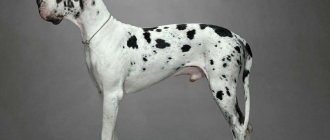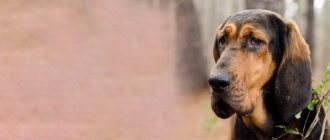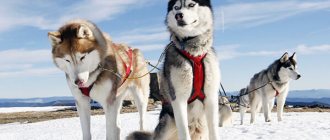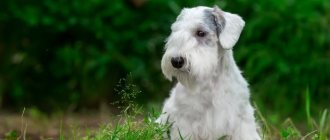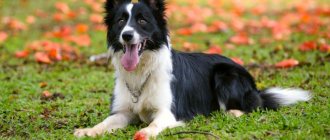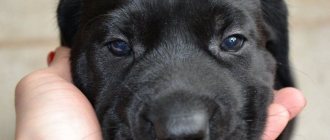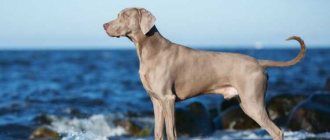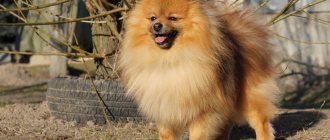To this day, people debate whether the Great Dane as a breed actually exists. In fact, this is the name given to individuals of the Great Dane who have special external characteristics. At the end of the 19th century, cynologists from Germany combined several dog breeds into one - the Great Dane.
They are very large dogs. Their height at the withers reaches 90 centimeters. In the United States, a representative of this breed, considered the most gigantic dog, died in 2013. He was eight years old, height at the withers - 1.1 m, and on the hind legs - 2.2 m. It’s time to learn about the characteristics of the breed and what else dog breeders call the marbled Great Dane.
Appearance of a dog of the Great Dane breed
The breed is one of the largest in the world. Males reach an average of 85 cm in length weighing up to 79 kg, females 78 cm weighing up to 63 kg.
The color of the Great Dane has different options: light gray, gray, black, white with black spots, shades of white. The hairs fit tightly. The coat is short and shiny.
The head from the front looks narrow at the nose, widening towards the ears. The eyes and brow ridges are clearly visible. The jaw is wide, rectangular in shape from the side. The oval nose is black, the corners of the mouth are clearly cut out.
Lean body, with developed muscles, visible when the dog moves. Towards the pelvic region, the torso narrows, the stomach is pressed towards the spine. The chest is wide. The back curves gracefully in the area below the shoulder blades. The paws are long and small in width. The contour of the forearms and hips is rounded. The tail is thin, straightened or raised.
The Great Dane is harmoniously developed, has proportional parts of the body. From the photo of the Great Dane, it is noticeable that the length of the back is slightly greater than the length at the withers. The ears originate high on the top of the head, lie along the cheeks or stand vertically upward. The neck is elongated, long, with strong muscles, and leans forward with a slight inclination.
Noble ancestors
Molossians are not the only ones who were noted during the formation of the breed. At the very, very beginning there were Asian fighting dogs. And if you are scrupulous, you can find information that even in those days the general branch was divided into two side branches. One was a pack dog, released on large animals in baiting, did not differ in large size and did not differ much from other hunting dogs. Another branch, which united much more massive individuals, was used primarily in protection. The Royal Dane breed originated from this line. To develop the necessary qualities, the original branch was crossed with greyhounds, the fastest dogs in the world, so that the bodyguard acquired the characteristics inherent in greyhounds.
Appearance of dogs of the Great Dane breed
The external characteristics of the Great Dane correspond to the standards developed by breeders specifically for this breed.
- The nose is black, except in marbled species. The wider the nose, while respecting the overall proportions, the better.
- Lips are dark.
- The eyes are dark in color and covered with tightly fitting eyelids.
- The neck is long.
- The back is short.
- The tail starts high and tapers towards the tip. Should not have coarse hairs.
- The lower border of the chest is located at the level of the elbows of the front legs. The chest is expanded.
- Paws are tightly closed, with dark nails.
- The borders of the ears touch the cheeks.
Violations of the standard are character traits - aggressiveness and cowardice.
Description and features
When a Great Dane dog appears on the street, the eyes of all surrounding people and animals turn to it. This is not surprising, because with all her appearance she inspires power and strength. However, she is not at all aggressive by nature. This is the main feature of the representative of the breed - the discrepancy between the character and appearance.
Let's delve a little into the history of the breed. It is believed that the first ancestors of Great Danes came from Tibet. It was there that most large dog breeds were selected. From the center of the Asian continent, animals quickly spread to other regions of the world, rapidly gaining popularity.
In ancient times, large dogs, including the one in question, were used for many “jobs”: protecting the territory, fighting, hunting big game, etc. It is worth noting that due to its peaceful nature, the Great Dane did not cope well with protection. He greeted each guest cordially, without fear that he might be an intruder. Except that his appearance can scare you away.
Why did the dog get the name “German”? It's simple. There have always been more huge guys in Germany than in other countries of the world. For some reason, the Germans fell in love with these charming animals more than others.
The functionality of a modern representative of the breed is just as universal as that of an old one. However, previously it was often used as a rider, but today it is extremely rare. But in vain. In terms of strength, the beast is very powerful. He is resilient and very brave.
Good nature does not prevent the Great Dane from being a reliable bodyguard. But in order to develop responsibility and observation in such a dog, it is recommended to raise it correctly. Fear is completely unknown to her. This is a desperate creature that will stop at nothing if its owner is in danger.
In addition, Great Danes are wonderful companions. They can faithfully wait for the owner from the store or go for a walk with him. They especially love sports. For example, you can invite such a pet to accompany you on a jog or take him with you on a bike ride.
It's hard to believe that these animals are incredibly affectionate and vulnerable. A rude word spoken to them will probably cause them to plunge into depression for several days. Therefore, when interacting with these funny four-legged pets, be kind and forgiving.
Great Dane breed groups
Based on coat color, there are 3 groups to which the dogs being raised correspond.
Fawn and brindle appearance of the Great Dane breed
- Pale cream to golden color, without white spots or foreign colors.
- The brindle pattern is a bright golden color with black stripes and no white spots.
Marbled and black appearance of the Great Dane breed
- White coat color with black spots on the body, no other colors.
- Black coat color, possible white spots.
Blue type of Great Dane breed
- Solid bluish-gray color with a silver tint.
Marbled Great Dane: roots
Judging by the name, the breed was obtained by the Germans from English mastiffs and Irish Greinhounds. In the old days, all species were called mastiffs, regardless of breed and color. In English, the word “dog” is translated as “dog”. The requirements for a marbled Great Dane have changed many times. At the moment, a representative of this breed should have a majestic body build, nobility, and elegance. The dog's appearance is harmonious, and its body proportions are ideal. The Great Danes can be compared to Apollo.
Character of the Great Dane
The dog has a calm disposition, is friendly with people, and loves children. The dimensions can cause harm to a person during the game. The dog is not aggressive, obedient, and is not always aware of its own size. The Great Dane is loyal to its owners, cheerful, and needs attention and communication.
The pet is intellectually developed and easily remembers commands. It is difficult to get angry; barking is caused by good reasons. He is wary of strangers.
Rules for caring for a Great Dane dog
A large dog feels more comfortable in a large area. There is not enough space in the apartment for sufficient physical activity. A dog does not bark without a reason. Needs human interaction. High and low temperatures are unpleasant.
It is ideal to keep it in a private house, where there will be a rather large sleeping place for the pet. Shedding is not a problem; the coat is short and needs brushing.
A dog living in the house needs to have its nails trimmed, its teeth brushed, bathed with a special shampoo, and its ears taken care of.
Breed characteristics
Great Danes are very kind and gentle. They faithfully serve the owner and are responsive to his entire family. The Marbled Great Dane loves to communicate and is not at ease being alone. At the same time, he sometimes shows his temper and stubbornness. If you have little experience in dog breeding, then you should not have such a pet. It must be remembered that the Great Dane needs a lot of attention. He can get dirty, slobber all over, make noise and do dirty tricks. You should walk your dog in very large areas where it can run without scaring passers-by. The Great Dane gets along well with children, they find a common language. The only catch is their height.
Great Dane nutrition
In addition to specialized food, the diet of adult animals includes natural products. It is preferable to use lean meat. Boiled cereals and vegetables improve intestinal motility and are a source of vitamins and minerals.
Diseases of the Great Dane breed
Diseases are associated with high dog growth. Well-developed muscles do not save bones from heavy loads. As an animal ages, it develops joint problems. Internal organs quickly wear out, heart and kidney diseases occur.
The quality and life expectancy of a dog are influenced by normal nutrition and reasonable physical activity.
Education and training
It is important to address the issue of raising a large domestic dog as early as possible. She must learn that dominance and disobedience are unprofitable behavioral strategies. A massive animal must respect everyone without exception, especially its owner-leader. To do this, it must be adjusted each time:
- Don't let your dog get on your bed.
- Scold her if she steals food from the table.
- Roll up a newspaper and gently slap it on the face if it bites.
- Always reward good behavior.
- Only go outside the house with your dog if it is completely calm.
- Offer to exercise at the same time of day to get her into the habit.
If your dog refuses to train, for example, to teach a command or jump over a fence, we advise you to interest him with a treat. Delicious food is the best motivator for a four-legged pet! Pat him on the head and say a few words of encouragement.
How to punish a guilty dog? Only verbally. Under no circumstances should you hit him. An animal will never forgive physical violence. Once you hit him, you will lose his trust forever. You can take your animal to sports stadiums from the first months of its life. The intensity of training increases gradually.
Blue Great Dane (interesting facts)
Gray dogs develop a blue tint to their fur in certain lighting conditions. This gives a special elegance to the breed. The Blue Great Dane has short hair that is not designed to withstand heat and cold. White spots may be present on the surface of the chest.
The dog is affectionate, cheerful, attentive to its surroundings. Hunter genes make themselves felt. It acts as a good guard for the owner.
Choosing a puppy
Preference should be given to a specialized nursery, where you will be provided with a pet with a full list of documents and pedigree. This will help to predict the animal’s psyche and be confident in the purity of the breed.
Try to establish contact with your future friend; if the dog is “yours”, you will immediately understand it. Prices for Great Danes in Russia vary from 15 to 80 thousand rubles.
Great Dane (interesting facts)
The Great Dane breed was recognized as independent and acquired its own standard of requirements. The dog has mastiff and greyhound genes.
Males can grow up to 80 cm, females no lower than 75 cm. Females have a smaller and more graceful physique. On the rectangular head there are triangular ears, the cropped ones stick up, the whole ones fall along the cheeks.
The color is dark: black, warm brown, brindle, beige. The back is short, legs are straight.
The dog does not require special care. The Great Dane should not be bathed frequently; the protective fatty film on the coat will disappear. The Danish breed has a special odor, which is removed by hygiene procedures with dry shampoo.
Long nails are cut off; if the animal is heavy, they can easily damage furniture and flooring. The teeth are kept in perfect condition, with dental treatment.
Training should be done from an early age. Mature adults will resist. Physical activity keeps the dog healthy and fit, energy is directed in a safe direction.
An intelligent dog is suitable for accompanying and guarding its owner. A dominant character causes problems. The owner should indicate his leading role during introductions.
Content
There should be no difficulties in caring for your pet, but you need to brush it regularly with a brush or a special rubber mitten. The large size of the dog tends to use dry shampoo for washing, as injuries can occur while washing off the foam products. The Great Dane is a fairly intelligent animal. But it is worth starting his training as early as possible. If you don’t teach your dog basic things in time, this will cause difficulties with maintenance and training in the future. It is customary to call this breed the Marbled Great Dane. Another name is royal or tiger. You should start raising a puppy immediately after purchasing it. Physical punishment and scolding should not be used on the dog, because such methods will make its character difficult. You should treat a Great Dane in the same way as a child. If he cannot do something, then it is worth providing a worthy alternative.
The Great Dane lives for about seven and a half years. To maintain health, careful monitoring is required, especially of the gastrointestinal tract. The digestive system is a weak point in such dogs. After feeding, you need to protect your pet from physical activity for at least forty minutes. Regular visits to the veterinarian and an adequate response to problems with the dog’s health are the key to his health and your joy for many years.
